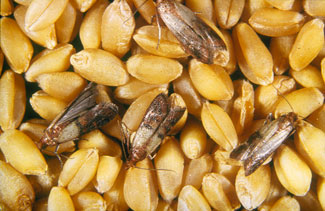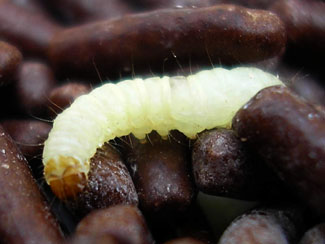They Might Not Be Clothes Moths
By Chris Williams on October 17, 2014.
We seem to have a clothes moth problem. I’ve seen several gray and brown small moths fluttering around the house. I notice them mostly in the evening when I’m trying to watch TV. How do I find the clothes that they’re infesting? I haven’t seen them in any closets. R. L., Plaistow, NH

Indian meal moths

Indian meal moth larva
I would question whether what you’re seeing are even clothes moths. Too many things don’t fit. Clothes moth are not gray or brown, but a lighter straw color. More importantly, the habits don’t fit clothes moths which are rarely seen. Clothes moths hide most of the time in dark places and avoid light.
You need to capture some moths and have a professional identify them. I suspect that what you have are some type of stored product moths, most likely Indian meal moths. Indian meal moths are bigger than clothes moths at about ½ inch long. Their wings are gray near the head, ending in a broad copper band at the tip, although the colored scales often get rubbed off. Indian meal moths become active after dusk, and will fly in a zig-zag pattern to lights and TVs.
While Indian meal moths are the most common food moths in homes, there are other possibilities–Mediterranean flour moths, angoumois grain moths, or almond moths. All infest bulk or packaged foods.
How to Find Food Moths
To check for food moths, look in pantries or on shelves where you have stored food items. Look in shelf corners and underneath shelves for whitish, wormlike larvae or their silken cocoons. Find the oldest packaged food products on your shelves since they are the most likely to be infested, and pour out the contents (see How to Check Food Products for Insects – Advice From the Pros). Even unopened boxes or bags can contain moth larvae. You may be able to verify an infestation with the first few products you check.
If you have an infestation of food moths, you really need to check all of your food products and probably throw out most of them. You should also consider having an exterminator treat your kitchen to kill any wandering larvae or any that hatch later from eggs. If you don’t find food moths, then you really should contact an exterminator for a more thorough inspection to find the source of the moths. Give Colonial a call today.
Moths: CSIRO [CC-BY-3.0], via Wikimedia Commons
Larva: By Pudding4brains [Public domain], via Wikimedia Commons